【中考考点清单】2014年中考英语(湖南专用 新课标)总复习课件:第二部分 语法专题突破 专题十五 情景交际(含13年中考试题)
文档属性
| 名称 | 【中考考点清单】2014年中考英语(湖南专用 新课标)总复习课件:第二部分 语法专题突破 专题十五 情景交际(含13年中考试题) | 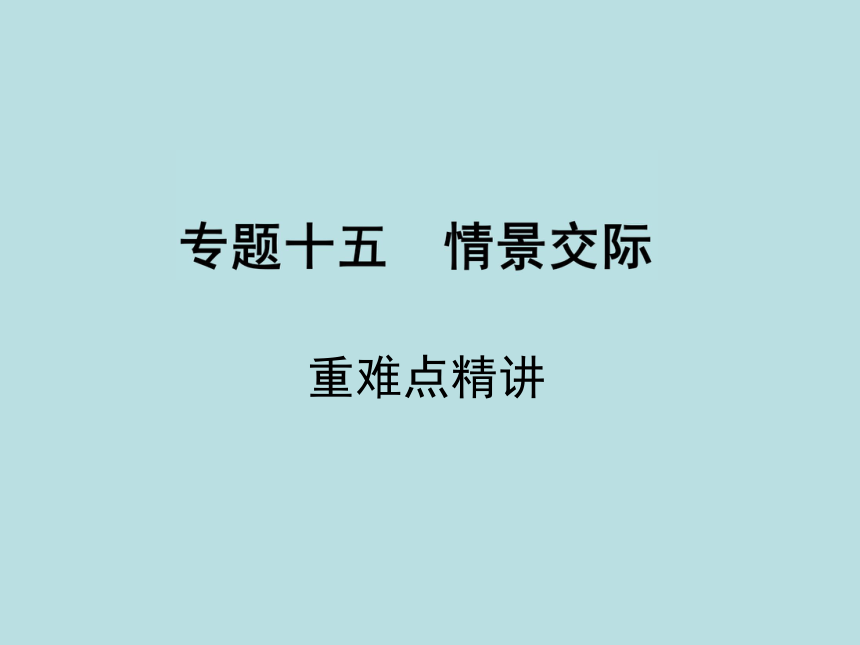 | |
| 格式 | zip | ||
| 文件大小 | 293.0KB | ||
| 资源类型 | 教案 | ||
| 版本资源 | 通用版 | ||
| 科目 | 英语 | ||
| 更新时间 | 2014-01-22 08:00:31 | ||
图片预览

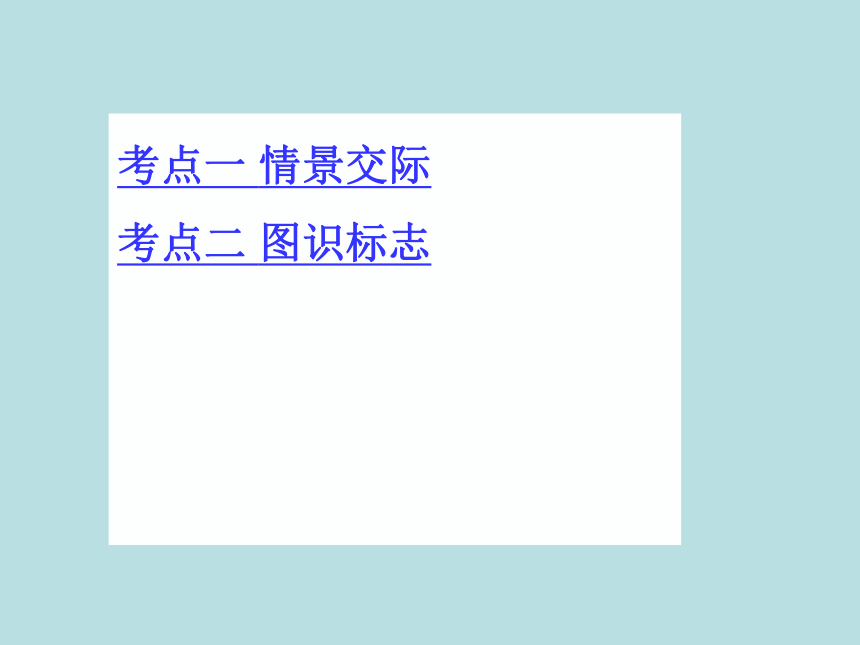
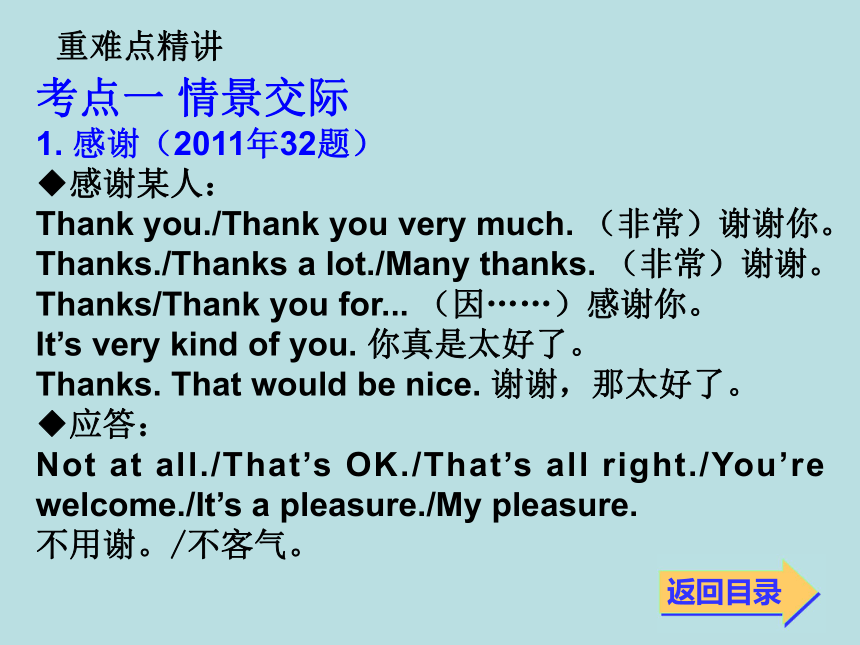
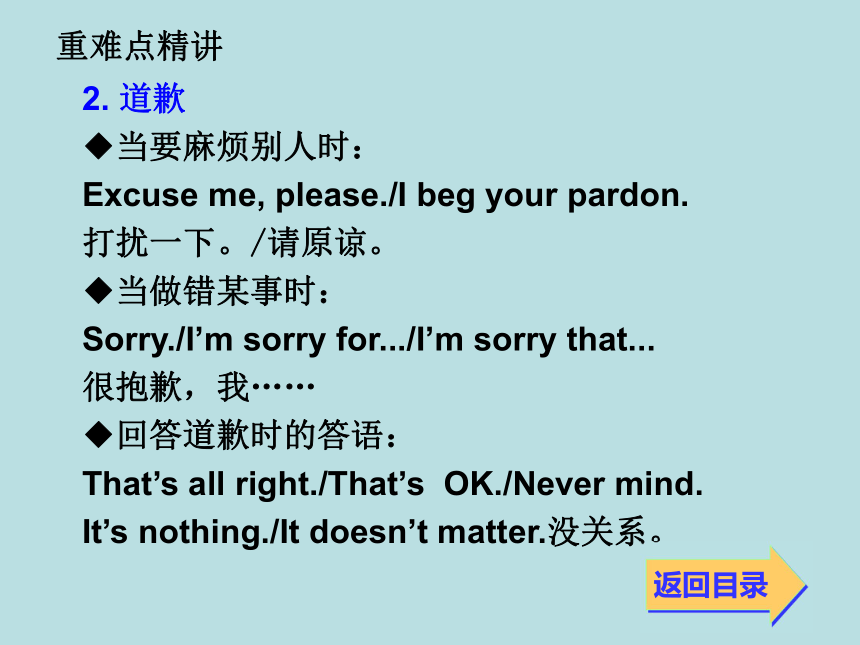
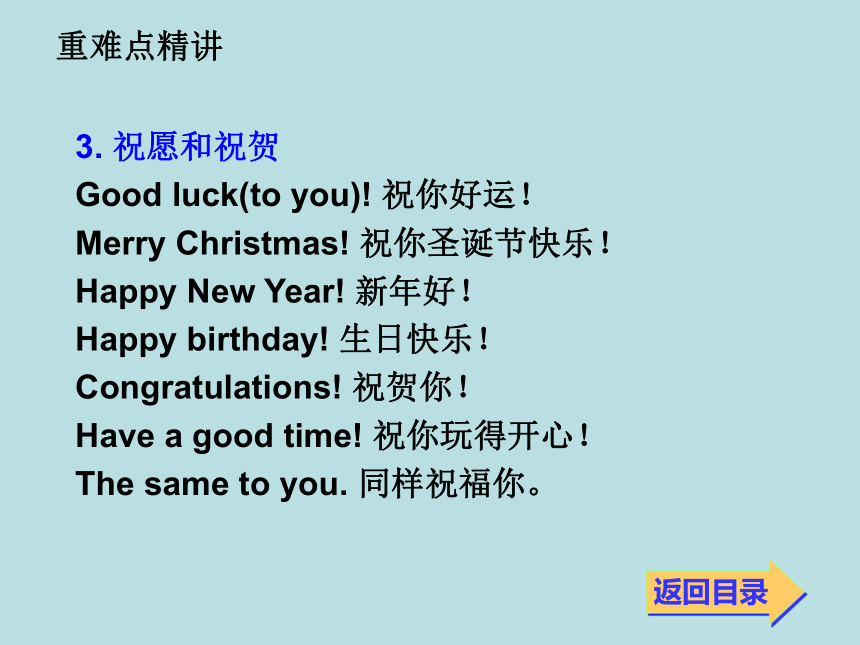
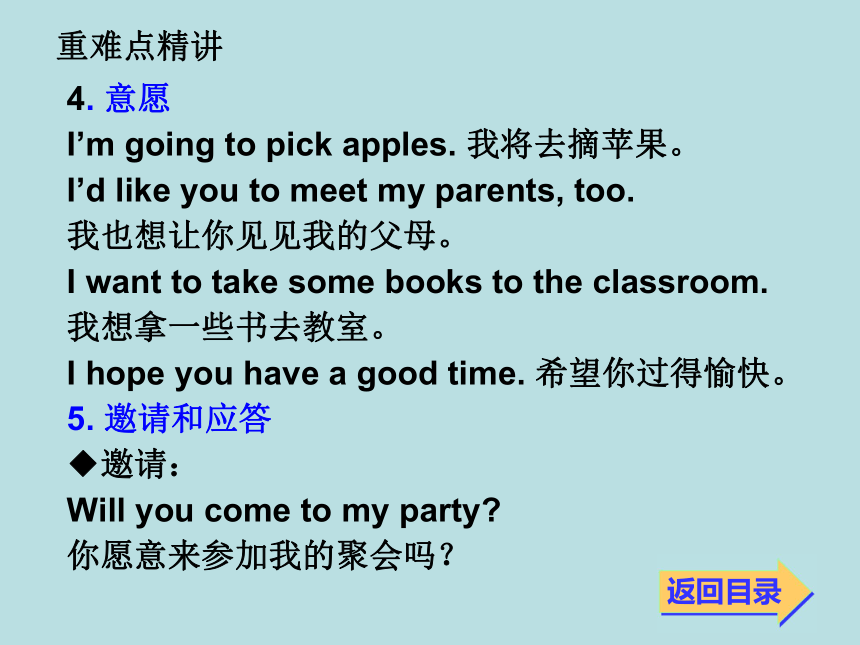
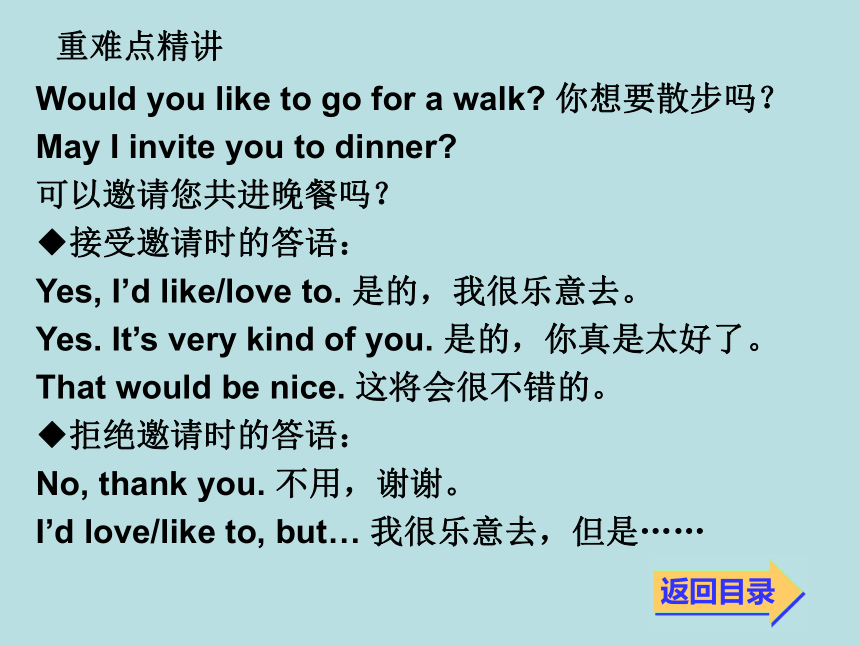
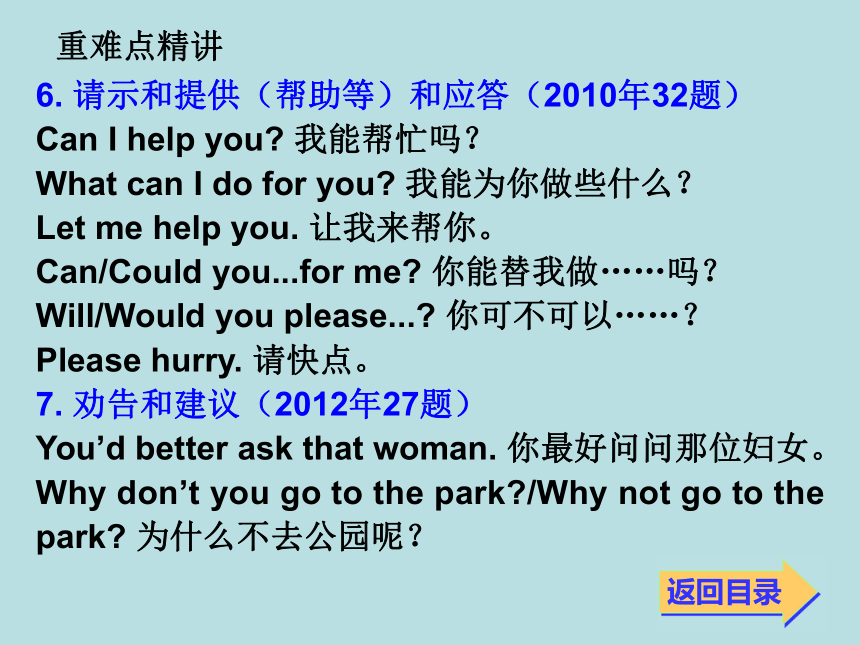
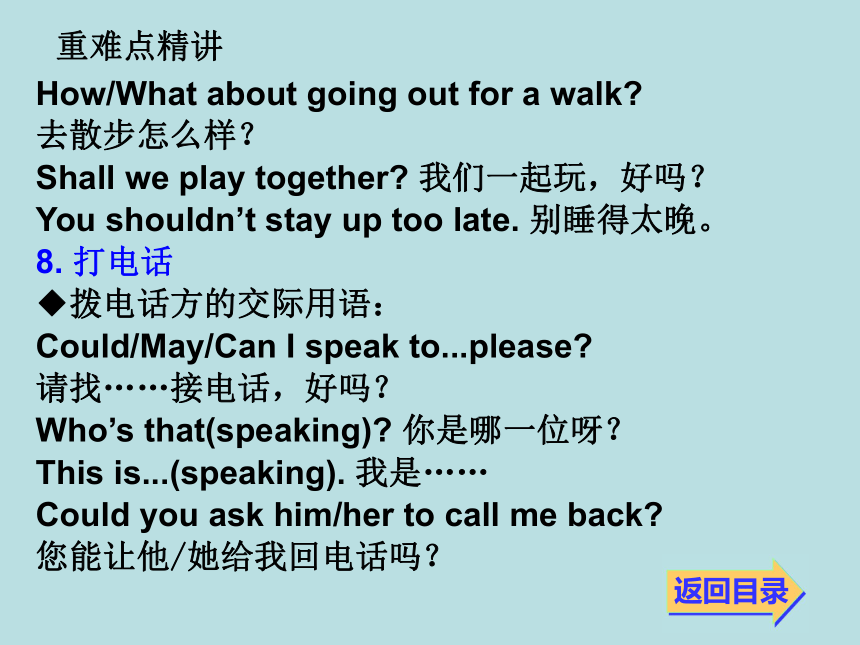
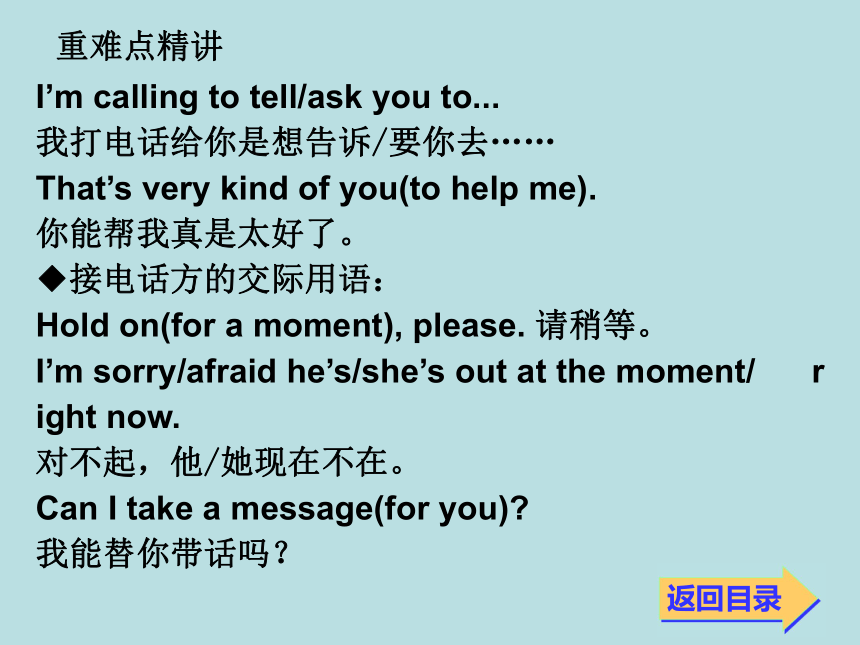

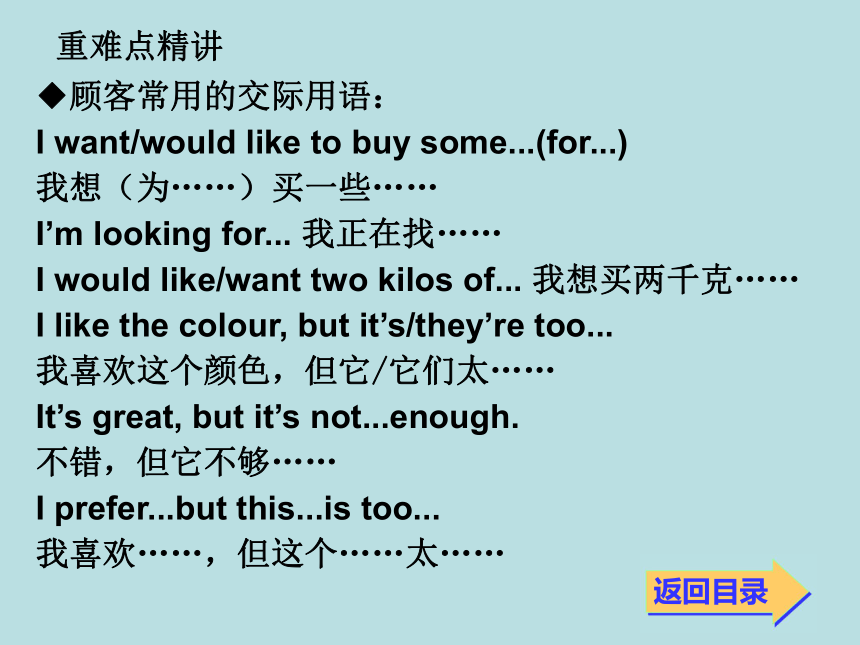
文档简介
课件33张PPT。
重难点精讲 专题十五 情景交际考点一 情景交际
考点二 图识标志
考点一 情景交际
1. 感谢(2011年32题)
◆感谢某人:
Thank you./Thank you very much. (非常)谢谢你。
Thanks./Thanks a lot./Many thanks. (非常)谢谢。
Thanks/Thank you for... (因……)感谢你。
It’s very kind of you. 你真是太好了。
Thanks. That would be nice. 谢谢,那太好了。
◆应答:
Not at all./That’s OK./That’s all right./You’re welcome./It’s a pleasure./My pleasure.
不用谢。/不客气。
返回目录重难点精讲2. 道歉
◆当要麻烦别人时:
Excuse me, please./I beg your pardon.
打扰一下。/请原谅。
◆当做错某事时:
Sorry./I’m sorry for.../I’m sorry that...
很抱歉,我……
◆回答道歉时的答语:
That’s all right./That’s OK./Never mind.
It’s nothing./It doesn’t matter.没关系。
返回目录重难点精讲
3. 祝愿和祝贺
Good luck(to you)! 祝你好运!
Merry Christmas! 祝你圣诞节快乐!
Happy New Year! 新年好!
Happy birthday! 生日快乐!
Congratulations! 祝贺你!
Have a good time! 祝你玩得开心!
The same to you. 同样祝福你。
返回目录重难点精讲4. 意愿
I’m going to pick apples. 我将去摘苹果。
I’d like you to meet my parents, too.
我也想让你见见我的父母。
I want to take some books to the classroom.
我想拿一些书去教室。
I hope you have a good time. 希望你过得愉快。
5. 邀请和应答
◆邀请:
Will you come to my party?
你愿意来参加我的聚会吗?返回目录重难点精讲Would you like to go for a walk? 你想要散步吗?
May I invite you to dinner?
可以邀请您共进晚餐吗?
◆接受邀请时的答语:
Yes, I’d like/love to. 是的,我很乐意去。
Yes. It’s very kind of you. 是的,你真是太好了。
That would be nice. 这将会很不错的。
◆拒绝邀请时的答语:
No, thank you. 不用,谢谢。
I’d love/like to, but… 我很乐意去,但是……
返回目录重难点精讲6. 请示和提供(帮助等)和应答(2010年32题)
Can I help you? 我能帮忙吗?
What can I do for you? 我能为你做些什么?
Let me help you. 让我来帮你。
Can/Could you...for me? 你能替我做……吗?
Will/Would you please...? 你可不可以……?
Please hurry. 请快点。
7. 劝告和建议(2012年27题)
You’d better ask that woman. 你最好问问那位妇女。
Why don’t you go to the park?/Why not go to the park? 为什么不去公园呢?
返回目录重难点精讲How/What about going out for a walk?
去散步怎么样?
Shall we play together? 我们一起玩,好吗?
You shouldn’t stay up too late. 别睡得太晚。
8. 打电话
◆拨电话方的交际用语:
Could/May/Can I speak to...please?
请找……接电话,好吗?
Who’s that(speaking)? 你是哪一位呀?
This is...(speaking). 我是……
Could you ask him/her to call me back?
您能让他/她给我回电话吗?
返回目录重难点精讲I’m calling to tell/ask you to...
我打电话给你是想告诉/要你去……
That’s very kind of you(to help me).
你能帮我真是太好了。
◆接电话方的交际用语:
Hold on(for a moment), please. 请稍等。
I’m sorry/afraid he’s/she’s out at the moment/ right now.
对不起,他/她现在不在。
Can I take a message(for you)?
我能替你带话吗?
返回目录重难点精讲9. 购物
◆营业员常用的交际用语:
Can I help you?/What can I do for you?
你要买什么?
How many/much...do you want? 你要多少……?
What about this one? 这件/种怎么样?
What colour/size/kind do you like/want?
你喜欢/想要什么颜色/尺寸/种类的?
I’m afraid we haven’t got any...in that size at the moment. 恐怕我们现在没有那个尺寸的……
Here you are. 给你。
返回目录重难点精讲◆顾客常用的交际用语:
I want/would like to buy some...(for...)
我想(为……)买一些……
I’m looking for... 我正在找……
I would like/want two kilos of... 我想买两千克……
I like the colour, but it’s/they’re too...
我喜欢这个颜色,但它/它们太……
It’s great, but it’s not...enough.
不错,但它不够……
I prefer...but this...is too...
我喜欢……,但这个……太……
返回目录重难点精讲Have you got any other kind/colour/size?
你们还有其他种类/颜色/尺寸的吗?
That looks nice/great. 看起来不错。
Have you got anything cheaper?
你们有更便宜点的吗?
How much does it cost? 多少钱?
Can/May I try them/it on, please?我能试一试吗?
10. 问路及应答
◆问路的交际用语:
Excuse me, where’s...? 劳驾,……在哪儿?
How can I get to...? 我怎样去……?
返回目录重难点精讲Which is the way to the...? 去……是哪一条路?
Could you tell me how to get to the...?
请问您能告诉我怎样去……吗?
How far is it? 有多远?
Which bus can I take? 我可以乘哪路车?
◆指路的交际用语:
It’s over there on the left/right. 在那儿左边/右边。
It’s next to the.../in front of the.../behind the.../outside the.../between... and...
它在……的旁边/前面/后面/外面/……和……之间。
It’s at the end of the street. 在街道的尽头。
返回目录重难点精讲Walk/Go along/down the road/the street, and take the second turning on the left/right.
沿着这条路/街,然后在第二个转弯处向左/右拐。
You’d better take/catch a bus. 你最好乘公共汽车。
Go down this street until you reach the second traffic light.
沿着这条街一直走到第二个交通灯那儿。
At the end of the road you’ll see the...
到路尽头你就会看到……
It will take you about half an hour.
大约要花半个小时到那儿。
Go across the bridge. 从桥上走过去。
返回目录重难点精讲
Go up this road to the end. 沿着这条路走到尽头。
Turn left/right at the second crossing.
从第二个十字路口向左/右拐。
You can’t miss it. 你不会错过的。
It’s about 15 minutes’ walk. 步行大约15分钟。
11. 看病
◆医生常用交际用语:
What’s wrong with you?/What’s the matter?/ What’s up? 你怎么了?
返回目录重难点精讲
How long have you been like this?你像这样多
久了?
Have you taken your temperature?你测过
体温吗?
Have you had anything to eat this
morning?
早晨你吃过什么东西吗?
There’s nothing serious. 不要紧,不严重。 重难点精讲返回目录
Take this medicine and stay in bed for a few days. 吃这个药并卧床休息几天。
You will get better soon. 你会很快好起来的。
You will be all right/well soon. 你会很快没事的。
◆病人常用的交际用语:
I have got a headache/cough. 我头痛/咳嗽。
I’m not feeling well./I don’t feel very well./I feel terrible. 我感觉不舒服。
There’s something wrong with... 我……不舒服。
重难点精讲返回目录12. 喜好和厌恶
◆喜欢:
—Which do you like better, ... or ...?
你喜欢(这两者)中的哪一个?
—I like ... better than...我喜欢……胜过……
—Which do you like best, ..., ...or...?
你最喜欢(这三者)中的哪一个?
—I like...best. 我最喜欢……
Would you like...? 你想要……吗?
I like/love...a lot/very much/a little.
我很/十分/有一点喜欢……
返回目录重难点精讲◆厌恶:
I don’t like...at all. 我一点也不喜欢……
I prefer to...rather than... 我宁可……也不……
13. 谈论天气
◆询问天气:
What’s the weather like today? 今天天气如何?
How is the weather in England?
英格兰的天气怎么样?
Lovely weather, isn’t it? 天气不错,不是吗?
◆描述天气:
It’s fine/cloudy/windy/rainy. 晴天/多云/有风/有雨。
返回目录重难点精讲It’s rather warm/cold/hot/etc. today, isn’t it?
今天很暖和/冷/热……,不是吗?
What a heavy rain! 好大的雨!
14. 就餐(2009年19题)
◆主人常用语:
What would you like to have? 你想要点什么呢?
Would you like something to drink?
想要喝点什么吗?
Help yourself to some chicken. 请随意吃点鸡肉。
◆客人常用语:
Yes, I’d like a drink. 好的,我想要点喝的。
I’d like rice and chicken. 我想要一些米饭和鸡肉。
返回目录重难点精讲Just a little, please. 我要一点。
Can I have some more soup? 我能再喝点汤吗?
It’s so delicious. Thank you. 非常美味,谢谢你。
No, thank you. I’ve had enough.
不用了,谢谢。我吃饱了。
I’m full, thank you. 我饱了,谢谢。
15. 情感(2010年31题)
◆高兴
How wonderful/nice! 太棒了!
That’s lovely/great/wonderful! 那很可爱/好/棒!
I’m happy. It’s well done. 我很高兴,干得好。
I’m pleased to know that. 我很高兴知道那事。
返回目录重难点精讲◆惊奇
Really? 真的吗?Oh dear! 噢,天哪!
Is that so? 是那样的吗?
What a surprise! 太惊讶了!
How nice to see you! 见到你真好!
How surprising! 太惊奇了!
I’m surprised. 我很惊讶。
◆满意
Good! 好!Well done! 干得好!
Perfect! 完美!That’s fine. 那很好。
That’s better. 那更好。
That’s good enough. 那足够好了。
返回目录重难点精讲◆忧虑
What’s wrong? 怎么了?
What’s the matter? 出什么问题了?
Anything wrong? 有什么问题吗?
What should we do? 我们该怎么办?
Are you worried about your health?
你担心自己的健康吗?
◆遗憾与同情
I’m so sorry! 很抱歉!It’s a great pity! 太遗憾了!
What a shame/pity! 真遗憾!
That’s too bad! 那太糟了!
I’m sorry to hear that. 听到这个消息我很难过。
返回目录重难点精讲【现学现用】
1. (’11 衡阳32题)--- What a beautiful picture you are drawing!
--- .
You’re great! B. I’m proud of you.
C.Thank you.
2. (’10衡阳32题)---Would you mind if I sit here?
--- . It’s for Miss Smith.
Better not B. Never mind
C. Of course not
C A返回目录重难点精讲3. (’12衡阳27题)—Would you like something to drink?
--- . I'm not thirsty.
A. Yes, please B. No, thanks C. Sorry
4. (’09衡阳19题)---Thank you so much for the present you sent me.
--- .
Please don’t say so
B. It’s not so good, I think
C. I’m glad you like it
B C返回目录重难点精讲5. (’10衡阳31题) --- Why not stay for a few more minutes?
--- . My parents will be worried.
A. All right B. Take your time
C. It’s getting late
6. --- Hello, may I speak to Sandy?
--- .
A. Yes, I’m Rose B. I’ll call back again
C. This is Sandy speaking
C C返回目录重难点精讲7. --- I am going to London to watch the Summer Olympic Games next month.
--- !
A. Have a good time B. It’s terrible
C. Good job
8. --- Have you ever heard of Zhang Lili?
--- Certainly, the most beautiful woman teacher, and .
A. good luck
B. I hope she’ll be better soon
C. I’m sorry to hear that
A B返回目录重难点精讲9. --- ?
--- Yes, please. I want a sweater.
A. How much B. Can I help you C. Excuse me
10. --- What about visiting our teachers on Teachers’ Day?
--- .
A. Good idea B. No way C. Have a good time
11. --- How’s the weather in Kunming?
--- .
A. I’m afraid so B. I love it C. It’s sunny
B A C返回目录重难点精讲12. --- Would you mind turning up the music?
--- . Dad is sleeping now.
A. Sorry, I can’t do it B. OK, I’ll do it
C. No, not at all
13. --- Would you like some rice?
--- . I’d rather have a piece of bread.
A. Yes, please B. No problem C. No, thanks
14. --- I’ll go to Japan for a trip next month.
--- Great! B
A. Good luck! B. Have a good time!
C. Best wishes!
A C B返回目录重难点精讲考点二 图识标志
图识标志在衡阳中没有涉及,但是图识标志在日常生活中处处可见。 图识标志包含常识、热点类辨认,生活常见的图片标识两大类。 熟悉常见的生活标识,是每一个中学生都应该具备的能力,也是英语这门语言实用性的体现之一,可以激起学生学习英语的兴趣和动力。学生应多关注生活常识、关注热点话题,并善于利用图片进行关联记忆。 对常见的生活标识,重点归纳如下:
返回目录重难点精讲常见图识标志
返回目录重难点精讲【现学现用】
15. Look! Which of the following signs is about the disabled? ____16. —Excuse me! Look at the sign ____on the wall.
—Sorry. I won’t keep the water running.
CA返回目录重难点精讲
重难点精讲 专题十五 情景交际考点一 情景交际
考点二 图识标志
考点一 情景交际
1. 感谢(2011年32题)
◆感谢某人:
Thank you./Thank you very much. (非常)谢谢你。
Thanks./Thanks a lot./Many thanks. (非常)谢谢。
Thanks/Thank you for... (因……)感谢你。
It’s very kind of you. 你真是太好了。
Thanks. That would be nice. 谢谢,那太好了。
◆应答:
Not at all./That’s OK./That’s all right./You’re welcome./It’s a pleasure./My pleasure.
不用谢。/不客气。
返回目录重难点精讲2. 道歉
◆当要麻烦别人时:
Excuse me, please./I beg your pardon.
打扰一下。/请原谅。
◆当做错某事时:
Sorry./I’m sorry for.../I’m sorry that...
很抱歉,我……
◆回答道歉时的答语:
That’s all right./That’s OK./Never mind.
It’s nothing./It doesn’t matter.没关系。
返回目录重难点精讲
3. 祝愿和祝贺
Good luck(to you)! 祝你好运!
Merry Christmas! 祝你圣诞节快乐!
Happy New Year! 新年好!
Happy birthday! 生日快乐!
Congratulations! 祝贺你!
Have a good time! 祝你玩得开心!
The same to you. 同样祝福你。
返回目录重难点精讲4. 意愿
I’m going to pick apples. 我将去摘苹果。
I’d like you to meet my parents, too.
我也想让你见见我的父母。
I want to take some books to the classroom.
我想拿一些书去教室。
I hope you have a good time. 希望你过得愉快。
5. 邀请和应答
◆邀请:
Will you come to my party?
你愿意来参加我的聚会吗?返回目录重难点精讲Would you like to go for a walk? 你想要散步吗?
May I invite you to dinner?
可以邀请您共进晚餐吗?
◆接受邀请时的答语:
Yes, I’d like/love to. 是的,我很乐意去。
Yes. It’s very kind of you. 是的,你真是太好了。
That would be nice. 这将会很不错的。
◆拒绝邀请时的答语:
No, thank you. 不用,谢谢。
I’d love/like to, but… 我很乐意去,但是……
返回目录重难点精讲6. 请示和提供(帮助等)和应答(2010年32题)
Can I help you? 我能帮忙吗?
What can I do for you? 我能为你做些什么?
Let me help you. 让我来帮你。
Can/Could you...for me? 你能替我做……吗?
Will/Would you please...? 你可不可以……?
Please hurry. 请快点。
7. 劝告和建议(2012年27题)
You’d better ask that woman. 你最好问问那位妇女。
Why don’t you go to the park?/Why not go to the park? 为什么不去公园呢?
返回目录重难点精讲How/What about going out for a walk?
去散步怎么样?
Shall we play together? 我们一起玩,好吗?
You shouldn’t stay up too late. 别睡得太晚。
8. 打电话
◆拨电话方的交际用语:
Could/May/Can I speak to...please?
请找……接电话,好吗?
Who’s that(speaking)? 你是哪一位呀?
This is...(speaking). 我是……
Could you ask him/her to call me back?
您能让他/她给我回电话吗?
返回目录重难点精讲I’m calling to tell/ask you to...
我打电话给你是想告诉/要你去……
That’s very kind of you(to help me).
你能帮我真是太好了。
◆接电话方的交际用语:
Hold on(for a moment), please. 请稍等。
I’m sorry/afraid he’s/she’s out at the moment/ right now.
对不起,他/她现在不在。
Can I take a message(for you)?
我能替你带话吗?
返回目录重难点精讲9. 购物
◆营业员常用的交际用语:
Can I help you?/What can I do for you?
你要买什么?
How many/much...do you want? 你要多少……?
What about this one? 这件/种怎么样?
What colour/size/kind do you like/want?
你喜欢/想要什么颜色/尺寸/种类的?
I’m afraid we haven’t got any...in that size at the moment. 恐怕我们现在没有那个尺寸的……
Here you are. 给你。
返回目录重难点精讲◆顾客常用的交际用语:
I want/would like to buy some...(for...)
我想(为……)买一些……
I’m looking for... 我正在找……
I would like/want two kilos of... 我想买两千克……
I like the colour, but it’s/they’re too...
我喜欢这个颜色,但它/它们太……
It’s great, but it’s not...enough.
不错,但它不够……
I prefer...but this...is too...
我喜欢……,但这个……太……
返回目录重难点精讲Have you got any other kind/colour/size?
你们还有其他种类/颜色/尺寸的吗?
That looks nice/great. 看起来不错。
Have you got anything cheaper?
你们有更便宜点的吗?
How much does it cost? 多少钱?
Can/May I try them/it on, please?我能试一试吗?
10. 问路及应答
◆问路的交际用语:
Excuse me, where’s...? 劳驾,……在哪儿?
How can I get to...? 我怎样去……?
返回目录重难点精讲Which is the way to the...? 去……是哪一条路?
Could you tell me how to get to the...?
请问您能告诉我怎样去……吗?
How far is it? 有多远?
Which bus can I take? 我可以乘哪路车?
◆指路的交际用语:
It’s over there on the left/right. 在那儿左边/右边。
It’s next to the.../in front of the.../behind the.../outside the.../between... and...
它在……的旁边/前面/后面/外面/……和……之间。
It’s at the end of the street. 在街道的尽头。
返回目录重难点精讲Walk/Go along/down the road/the street, and take the second turning on the left/right.
沿着这条路/街,然后在第二个转弯处向左/右拐。
You’d better take/catch a bus. 你最好乘公共汽车。
Go down this street until you reach the second traffic light.
沿着这条街一直走到第二个交通灯那儿。
At the end of the road you’ll see the...
到路尽头你就会看到……
It will take you about half an hour.
大约要花半个小时到那儿。
Go across the bridge. 从桥上走过去。
返回目录重难点精讲
Go up this road to the end. 沿着这条路走到尽头。
Turn left/right at the second crossing.
从第二个十字路口向左/右拐。
You can’t miss it. 你不会错过的。
It’s about 15 minutes’ walk. 步行大约15分钟。
11. 看病
◆医生常用交际用语:
What’s wrong with you?/What’s the matter?/ What’s up? 你怎么了?
返回目录重难点精讲
How long have you been like this?你像这样多
久了?
Have you taken your temperature?你测过
体温吗?
Have you had anything to eat this
morning?
早晨你吃过什么东西吗?
There’s nothing serious. 不要紧,不严重。 重难点精讲返回目录
Take this medicine and stay in bed for a few days. 吃这个药并卧床休息几天。
You will get better soon. 你会很快好起来的。
You will be all right/well soon. 你会很快没事的。
◆病人常用的交际用语:
I have got a headache/cough. 我头痛/咳嗽。
I’m not feeling well./I don’t feel very well./I feel terrible. 我感觉不舒服。
There’s something wrong with... 我……不舒服。
重难点精讲返回目录12. 喜好和厌恶
◆喜欢:
—Which do you like better, ... or ...?
你喜欢(这两者)中的哪一个?
—I like ... better than...我喜欢……胜过……
—Which do you like best, ..., ...or...?
你最喜欢(这三者)中的哪一个?
—I like...best. 我最喜欢……
Would you like...? 你想要……吗?
I like/love...a lot/very much/a little.
我很/十分/有一点喜欢……
返回目录重难点精讲◆厌恶:
I don’t like...at all. 我一点也不喜欢……
I prefer to...rather than... 我宁可……也不……
13. 谈论天气
◆询问天气:
What’s the weather like today? 今天天气如何?
How is the weather in England?
英格兰的天气怎么样?
Lovely weather, isn’t it? 天气不错,不是吗?
◆描述天气:
It’s fine/cloudy/windy/rainy. 晴天/多云/有风/有雨。
返回目录重难点精讲It’s rather warm/cold/hot/etc. today, isn’t it?
今天很暖和/冷/热……,不是吗?
What a heavy rain! 好大的雨!
14. 就餐(2009年19题)
◆主人常用语:
What would you like to have? 你想要点什么呢?
Would you like something to drink?
想要喝点什么吗?
Help yourself to some chicken. 请随意吃点鸡肉。
◆客人常用语:
Yes, I’d like a drink. 好的,我想要点喝的。
I’d like rice and chicken. 我想要一些米饭和鸡肉。
返回目录重难点精讲Just a little, please. 我要一点。
Can I have some more soup? 我能再喝点汤吗?
It’s so delicious. Thank you. 非常美味,谢谢你。
No, thank you. I’ve had enough.
不用了,谢谢。我吃饱了。
I’m full, thank you. 我饱了,谢谢。
15. 情感(2010年31题)
◆高兴
How wonderful/nice! 太棒了!
That’s lovely/great/wonderful! 那很可爱/好/棒!
I’m happy. It’s well done. 我很高兴,干得好。
I’m pleased to know that. 我很高兴知道那事。
返回目录重难点精讲◆惊奇
Really? 真的吗?Oh dear! 噢,天哪!
Is that so? 是那样的吗?
What a surprise! 太惊讶了!
How nice to see you! 见到你真好!
How surprising! 太惊奇了!
I’m surprised. 我很惊讶。
◆满意
Good! 好!Well done! 干得好!
Perfect! 完美!That’s fine. 那很好。
That’s better. 那更好。
That’s good enough. 那足够好了。
返回目录重难点精讲◆忧虑
What’s wrong? 怎么了?
What’s the matter? 出什么问题了?
Anything wrong? 有什么问题吗?
What should we do? 我们该怎么办?
Are you worried about your health?
你担心自己的健康吗?
◆遗憾与同情
I’m so sorry! 很抱歉!It’s a great pity! 太遗憾了!
What a shame/pity! 真遗憾!
That’s too bad! 那太糟了!
I’m sorry to hear that. 听到这个消息我很难过。
返回目录重难点精讲【现学现用】
1. (’11 衡阳32题)--- What a beautiful picture you are drawing!
--- .
You’re great! B. I’m proud of you.
C.Thank you.
2. (’10衡阳32题)---Would you mind if I sit here?
--- . It’s for Miss Smith.
Better not B. Never mind
C. Of course not
C A返回目录重难点精讲3. (’12衡阳27题)—Would you like something to drink?
--- . I'm not thirsty.
A. Yes, please B. No, thanks C. Sorry
4. (’09衡阳19题)---Thank you so much for the present you sent me.
--- .
Please don’t say so
B. It’s not so good, I think
C. I’m glad you like it
B C返回目录重难点精讲5. (’10衡阳31题) --- Why not stay for a few more minutes?
--- . My parents will be worried.
A. All right B. Take your time
C. It’s getting late
6. --- Hello, may I speak to Sandy?
--- .
A. Yes, I’m Rose B. I’ll call back again
C. This is Sandy speaking
C C返回目录重难点精讲7. --- I am going to London to watch the Summer Olympic Games next month.
--- !
A. Have a good time B. It’s terrible
C. Good job
8. --- Have you ever heard of Zhang Lili?
--- Certainly, the most beautiful woman teacher, and .
A. good luck
B. I hope she’ll be better soon
C. I’m sorry to hear that
A B返回目录重难点精讲9. --- ?
--- Yes, please. I want a sweater.
A. How much B. Can I help you C. Excuse me
10. --- What about visiting our teachers on Teachers’ Day?
--- .
A. Good idea B. No way C. Have a good time
11. --- How’s the weather in Kunming?
--- .
A. I’m afraid so B. I love it C. It’s sunny
B A C返回目录重难点精讲12. --- Would you mind turning up the music?
--- . Dad is sleeping now.
A. Sorry, I can’t do it B. OK, I’ll do it
C. No, not at all
13. --- Would you like some rice?
--- . I’d rather have a piece of bread.
A. Yes, please B. No problem C. No, thanks
14. --- I’ll go to Japan for a trip next month.
--- Great! B
A. Good luck! B. Have a good time!
C. Best wishes!
A C B返回目录重难点精讲考点二 图识标志
图识标志在衡阳中没有涉及,但是图识标志在日常生活中处处可见。 图识标志包含常识、热点类辨认,生活常见的图片标识两大类。 熟悉常见的生活标识,是每一个中学生都应该具备的能力,也是英语这门语言实用性的体现之一,可以激起学生学习英语的兴趣和动力。学生应多关注生活常识、关注热点话题,并善于利用图片进行关联记忆。 对常见的生活标识,重点归纳如下:
返回目录重难点精讲常见图识标志
返回目录重难点精讲【现学现用】
15. Look! Which of the following signs is about the disabled? ____16. —Excuse me! Look at the sign ____on the wall.
—Sorry. I won’t keep the water running.
CA返回目录重难点精讲
同课章节目录
- 词法
- 名词
- 动词和动词短语
- 动词语态
- 动词时态
- 助动词和情态动词
- 非谓语动词
- 冠词
- 代词
- 数词和量词
- 形容词副词及其比较等级
- 介词和介词短语
- 连词和感叹词
- 构词法
- 相似、相近词比较
- 句法
- 陈述句
- 一般疑问句和否定疑问句
- 特殊疑问句及选择疑问句
- 反意疑问句
- 存在句(There be句型)
- 宾语从句
- 定语从句
- 状语从句
- 主谓一致问题
- 简单句
- 并列句
- 复合句
- 主谓一致
- 主、表语从句
- 名词性从句
- 直接引语和间接引语
- 虚拟语气
- 感叹句
- 强调句
- 倒装句
- 祈使句
- 句子的成分
- 句子的分类
- 题型专区
- 单项选择部分
- 易错题
- 完形填空
- 阅读理解
- 词汇练习
- 听说训练
- 句型转换
- 补全对话
- 短文改错
- 翻译
- 书面表达
- 任务型阅读
- 语法填空
- 其他资料
